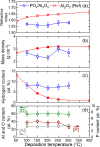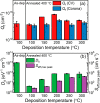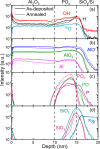PO x /Al2O3 Stacks for c-Si Surface Passivation: Material and Interface Properties
- PMID: 34723186
- PMCID: PMC8552444
- DOI: 10.1021/acsaelm.1c00516
PO x /Al2O3 Stacks for c-Si Surface Passivation: Material and Interface Properties
Abstract
Phosphorus oxide (PO x ) capped by aluminum oxide (Al2O3) has recently been discovered to provide excellent surface passivation of crystalline silicon (c-Si). In this work, insights into the passivation mechanism of PO x /Al2O3 stacks are gained through a systematic study of the influence of deposition temperature (T dep = 100-300 °C) and annealing temperature (T ann = 200-500 °C) on the material and interface properties. It is found that employing lower deposition temperatures enables an improved passivation quality after annealing. Bulk composition, density, and optical properties vary only slightly with deposition temperature, but bonding configurations are found to be sensitive to temperature and correlated with the interface defect density (D it), which is reduced at lower deposition temperature. The fixed charge density (Q f) is in the range of + (3-9) × 1012 cm-2 and is not significantly altered by annealing, which indicates that the positively charged entities are generated during deposition. In contrast, D it decreases by 3 orders of magnitude (∼1013 to ∼1010 eV-1 cm-2) upon annealing. This excellent chemical passivation is found to be related to surface passivation provided by hydrogen, and mixing of aluminum into the PO x layer, leading to the formation of AlPO4 upon annealing.
© 2021 The Authors. Published by American Chemical Society.
Conflict of interest statement
The authors declare no competing financial interest.
Figures









References
-
- Dingemans G.; Kessels W. M. M. Status and prospects of Al2O3-based surface passivation schemes for silicon solar cells. J. Vac. Sci. Technol., A 2012, 30 (4), 040802.10.1116/1.4728205. - DOI
-
- Bonilla R. S.; Hoex B.; Hamer P.; Wilshaw P. R. Dielectric surface passivation for silicon solar cells: A review. Phys. Status Solidi A 2017, 214 (7), 1700293.10.1002/pssa.201700293. - DOI
-
- Melskens J.; van de Loo B. W.; Macco B.; Black L. E.; Smit S.; Kessels W. M. M. Passivating contacts for crystalline silicon solar cells: From concepts and materials to prospects. IEEE Journal of Photovoltaics 2018, 8 (2), 373–388. 10.1109/JPHOTOV.2018.2797106. - DOI
-
- Black L. E.; Van De Loo B. W. H.; Macco B.; Melskens J.; Berghuis W. J. H.; Kessels W. M. M. Explorative studies of novel silicon surface passivation materials: Considerations and lessons learned. Sol. Energy Mater. Sol. Cells 2018, 188, 182–189. 10.1016/j.solmat.2018.07.003. - DOI
LinkOut - more resources
Full Text Sources
